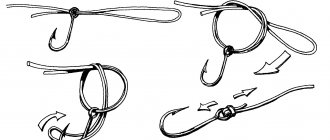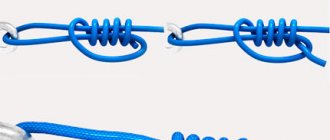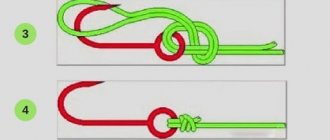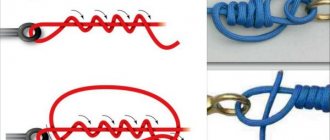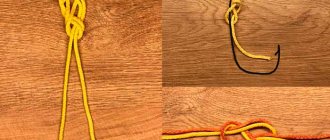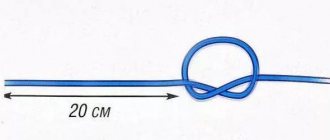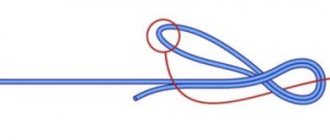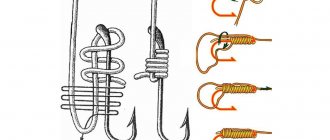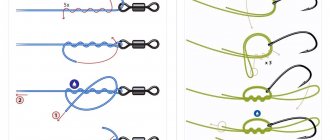Self-tightening knot - what is it?
Most types of knots and methods of tying them came to the modern world from the navy, although in this area it is used infrequently due to its unreliability. The fact is that a self-tightening knot holds tightly only under constant load; at the moment of weakening, it is quite capable of coming undone. Despite this, there are areas for its application.
This is the simplest original knot and in general represents one of the simplest types of noose. This unit reliably withstands heavy weight and traction, proportional to the strength of the cable or other material from which it is made. But you need to be careful when using it, making sure that the load on the node does not weaken.
For better reliability, there are several variations of this unit.
How to make such a design
The main feature of such a loop is that it will be reliable if there is a load on the running end. At the same time, it must be on a permanent basis, otherwise such a nodal structure will come undone without any problems. The sequence of actions to create such a node:
- We select a support to secure the knot, for example, a tree trunk, a pole or other support. We make a half ring around the base;
- Next, we pass the end under the main rope and insert it into the created loop;
- Pull the running end and tighten the node connection.
The result is a truly high-quality knot that will press the running end to the base, preventing it from coming undone.
Tying a knot
The methods of tying this knot are among the simplest and fastest. All you need to create it is a rope with a running end and a support. Fishermen use a spool for this purpose.
The end of the rope is wrapped around the support, thus forming an open loop. At the end of the rope or fishing line you need to form a loop. First make a winding around it behind the running end and create a closed loop. The running end of the loop needs to be made several turns and brought out through the main loop. Pull it, the knot will tighten and, when loaded, show all its power.
To improve the strength of the knot itself when knitting, a self-tightening knot with half bayonets is used. It is performed no more difficult than the standard one. After performing the basic knitting technique, two half-bayonets are formed on the weight side. This type achieves maximum effect when certain conditions are met:
- if it is formed off-center;
- if the running end should be directed towards the intended load.
Varieties
Today there are different types of self-tightening structures. The most popular include options with a half bayonet, cow, blind loop, constrictor. They differ in the complexity of knitting and appearance.
With half bayonet
It must be tied in the same way as the classic pattern. The only difference is that the free tip is re-drawn around the support and inserted behind the main cable into the resulting loop. If the length of the twine allows, you can make not one, but several ties.
Bovine
The bond turns out to be very strong and reliable. It is actively used not only in the navy, but also in everyday life. The rope is tied in exactly the same way as in the half-bayonet pattern, but upside down.
Blind loop
Tying involves threading one loop into another and then tightening it. The quality of the components does not depend on the effects of constant pressure. It is enough just to tie a rope, clamp it tightly, and the structure will hold on its own.
Constrictor
The most durable strong option that will not come undone after tightening tightly. You need to pass the folded running end into the loop; if necessary, just pull it. Usually, to break the bundle, you have to cut the string. The constrictor is used for joining carpets, tying bags, and rubber hoses. The pattern allows you to make marks on the ropes in specific places, since the marks do not slip off during use. The method is ideal for tying on round objects.
Durable constrictor is often used in warehouses. With its help, bags filled with flour, sugar, and cereals are hung on the crossbars. This allows you to protect products from rodents, dampness and other negative factors.
Where is it used?
He will find his place in all spheres of life. It is often used in mountaineering and in warehouses (they are used for hanging heavy objects). Fishermen use it when tying gear for fishing from the shore.
Shock-absorbing units are popular. They are formed on an additional rope, which is used to connect a spare fastening in case of destruction of the main one. There are also self-tightening units for transporting goods or for various rescue operations. These include the braking unit, “belts” and mariner.
There are two types of fastenings - simple and complex, for different life situations. In the navy, the original self-tightening knot is rarely used, with preference given to its variations.
Leash loop on main line
When fishing with a float, sometimes you may want to organize a couple of side leads on the main line with additional hooks. This can be done by tying the leashes to the loops on the main line.
The video below clearly shows the process of organizing the connection of the leashes and the main line using loops.
You can also see the article about knots for tying hooks to fishing line. The manual contains instructions with the most reliable components for a given case.
Fastening
The mount is often popular with fishermen. Although experienced fishermen suggested tying a self-tightening knot for fishing line without additional parts, their use makes life much easier. The fastening helps to fix the loops during knitting, prevents the knot from unraveling abruptly, and simplifies the knitting process. On the shelves of fish stores you can now see reels with a stopper for attaching braid. Many anglers reel in the line held by the spool without unnecessary fasteners, but only those who have gained experience over many years.
Application
Self-tightening knots are used not only by climbers and sailors. Some sources claim that there are about twenty such schemes. Knowing them all is not necessary even for a professional. But some universal combinations can be useful to the common man.
When relaxing outdoors, the “constrictor” knot will securely secure the hammock, and the “gazebo” will help to equip a canopy from the rain. For housewives, there is a “burlak sea loop” if there is a need to tighten a clothesline from sagging or organize drying for collected medicinal herbs. When walking your dog, sometimes it becomes necessary to leave your pet securely tied to a support for a while. A simple cow knot will do the trick. It knits easily and quickly allows you to release the leash.
This is interesting: Bunny ears knot: knitting pattern
Self-tightening fishing line knots are a must have in any fisherman's arsenal. They are also useful for securely fastening the boat. For those going on a mountain hike, knowledge of the components for belay equipment is simply necessary.
Kinds
There are 18 types of self-tightening knots in total, but using one rope there are only 4 types:
● Classic Prusik.
● Cross.
● With an “arb” carbine.
● Bachmann knot (with carabiner).
The number of turns is unstable; if necessary, it can be increased.
It is necessary to highlight one of the strongest knots - the constrictor knot. It gets its name from the zoological name for the boa constrictor, Boa constrictor, which defeats its prey by strangulation. This self-tightening rope knot is reliable and is made using rounded objects instead of support. As soon as the support disappears, it dissolves itself.
Using a node connection
The self-tightening rope knot has found its greatest application in the navy. They are the simplest and most reliable, learning to knit them is not difficult. In addition, such loops are actively used in mountaineering and maritime affairs, however, their use is quite possible in home life.
The main use of such tightening knots helps in the following cases:
- In order to hang a hammock or attach hanging structures;
- Attach a rope for drying clothes or various herbs;
- With its help, you can tie up an animal on the street or walk various goats or cows;
- When fishing, it helps to tie the boat and fishing line to the fishing rod;
- It is also often used in the manufacture of various costume jewelry such as bracelets or other products.
The main purpose of self-tightening knot connections is to fix a rope on a stationary object or the ability to fix a load on the rope itself, while the load itself will move along the knot product.
Use of the knot by anglers
A self-tightening knot for the top of the head is actively used by fishermen. It is a structure made from a block of tops with a weight. Tying such a tackle is quite simple.
To do this you will need a fishing line, a double leader and a sinker. A special sinker must be purchased at the store, otherwise the entire device may fail. Most often it looks like a horseshoe with a hole in the center of the product. The top bar is tightened using a self-tightening knot and hung with hooks.
To decorate the tackle, take a fishing line 4 mm in diameter and up to 50 cm in length. The line is pushed through the hole into the sinker to the middle, after which it is brought up. Insulation is put on it and a loop is made. After this, a self-tightening knot is formed, onto which the crown is attached. The insulation serves as a fastener for a long leash on the side of the free end of the fishing line, on which a swivel is attached to protect the fishing line from twisting in the current. Having secured the cake block with hooks, you can consider the task completed. The workpiece is attached with a carabiner to the main fishing line. The bait is ready to be cast. Getting into the water, it gradually gets wet, and the crumbling cake from the top spreads in the reservoir, attracting the desired fish.
Sea knots. Tightening knots
|
|
|
|
|
|
|
|
|
|
|
|
|
|
|
|
|
|
|
|
In the picture: self-tightening knot.
SELF-TIGHTENING KNOT. Of all the primitive knots, this one is perhaps the most original, as they say “it couldn’t be simpler.” You can apply a pull to the root part of the cable of this unit, and it will hold securely. The greater the thrust, the more strongly the hose presses against the free running horses, and the knot tightens itself. This is essentially the simplest form of a noose.
The knot should be used with great care. It must be remembered that it is reliable only when it is tied around a spar and constant force is applied to the root end. If this force is applied to the cable alternately, as if in jerks, then the running end may break out from under the root end of the cable. It makes sense to use this knot in cases where the load suspended from the root end is motionless and the direction of thrust to this end does not change.
In the picture: a self-tightening knot with a half bayonet.
SELF-TIGHTENING KNOT WITH HALF PIN. By adding one or two half-pins to a self-tightening knot, we get a more reliable knot that can be used for various purposes.
In the picture: cow knot.
COW KNOT. Despite its prosaic name, it is considered a reliable maritime hub. It holds flawlessly if traction is applied to the cable. In fact, it is an incorrect (inverted) bayonet that works in a different capacity. Since ancient times, this knot has been used on ships for attaching ropes to the outer shrouds using a line, for temporarily securing the cable to the eye when stretching it for lashing and tugging.
In the picture: blind loop.
Blind loop. If the running and root ends of a cow knot are connected together and a pull is applied to both ends, then the knot thus obtained will already be called a blind loop.
In the picture: bleaching unit.
CLOVE HITCH. Ships have long been attached to the shrouds with castings - transverse sections of resin cable, serving as steps for climbing the masts, were fastened with this particular knot. Hence its name.
The knot consists of two half-bayonets tied in the same direction. Very reliable, holds without fail as long as traction is applied to both ends of the cable. It is extremely convenient for attaching cables to objects that have a smooth surface, such as a mast, yard, boom, etc. In the days of the sailing fleet, in addition to its main purpose, this knot was used for tying the main ends of the topmast drapes on the top of the topmast.
There are two ways to knit a bleached knot. The first is used in cases where one of the ends of the object around which the knot is tied is open and accessible, the second - when the cable has to be carried directly around the object. The tapping unit is very convenient for feeding a tool (for example, a hammer when working at height). When weaving many types of nets, these knots form the first row of knitting. However, when using a tapping unit, you should always remember that it is reliable only with constant traction on the cable. A type of bleaching knot is a knot that serves to attach the buoy to the trend of the Admiralty anchor. In the latter case, the running end of the cable must have a button and is grabbed to the anchor spindle with a claw or a bezel.
In the picture: a retractable bayonet.
LOCKING BAYONET. On sailing ships, this unit was more widely used than the bleached one, since it is more advanced and reliable. It can also be used in cases where the direction of the cable pull is directed at an acute angle to the spar or the cable to which it is attached. The retractable bayonet holds even if the thrust is directed almost along the spar. Unlike the tapping unit, the sliding bayonet has not two, but three hoses covering the object; one on one side of the root end and two on the other. It is necessary to take into account which direction the pull at the root end will be directed, and depending on this, knit a knot. It’s easy to remember: which side is the pull - there are two hoses.
In the picture: constrictor.
"CONSTRICTOR". The knot, known throughout the world by this name, is one of the most tightly tightened knots. At the same time, it is considered one of the most difficult knots to untie. As a rule, it is not even untied; it serves only once. It tightens well if it is tied on round objects that do not have sharp corners; in this case it is irreplaceable.
In the picture: double constector.
DOUBLE CONSTRUCTOR. Although this knot is more complex than the “constrictor”, it tightens even more tightly.
In the picture: Python knot.
PYTHON KNOT. Doesn't have any special differences from the Constrictor. They are similar in knitting principle. The Python knot is applicable in the same cases as the Constrictor. In addition, it can be useful when tying together two cross slats. Their connection with this knot will be much stronger than with nails.
In the picture: miner's knot.
MINER'S UNIT. Simple, original and reliable. Holds well under constant load. Apparently, it got its name due to the fact that it was used in the mines. It can be successfully used both on land and at sea.
In the picture: picket unit.
PICKET UNIT. It is somewhat reminiscent of a bleached one, and although its design is different, it can be used for the same purposes. Apparently, it got its name from the fact that they used it to tie a cable to the risers when making pickets.
In the picture: gaff knot.
GAFEL KNOT. The name itself indicates that it is from the family of sea knots. In our time, it has been undeservedly forgotten, although it can always be used if necessary to quickly attach a cable to some cylindrical object.
In the picture: fox knot.
LISEL KNOT. On sailing ships, additional sails were called foxes; they were placed on both sides of straight sails on special spar trees - fox-spirits. The foil was attached with pins to the foil-yard with a foil knot. Although the foil knot has lost its intended purpose in the navy, it can be used to attach a cable to a round spar.
In the picture: a halyard knot. FALK KNOT. On a sailing ship, straight sails, which were placed between the topsail yard and the lower yardarm, were called “topsails.” Depending on which mast the sail belonged to, it was called “main-topsail” on the mainmast, or “fore-topsail” on the foremast. The gear that raised the yards of these sails was called “main-mars-halyard” and “fore-mars-halyard”. These tackles were attached to the yard with a halyard knot. Like the lissa knot, the halyard knot is considered a reliable sea knot.
In the picture: pike knot.
PIKE KNOT. Like the two previous nodes, it is used to attach the cable to cylindrical objects. The pike knot is much simpler than the halyard knot.
In the picture: camel knot.
CAMEL KNOT. It is used when it is necessary to tie one thin cable to another, thicker one for traction at any angle. When tied correctly, it does not slip left or right. It is always easy to untie, even if it gets wet and is very tight.
In the picture: locking unit.
STOP KNOT. When performing various ship work on deck, sometimes it becomes necessary to hold a cable under tension. This is done with the help of another cable, one end of which is secured to an eye or a butt on the deck, while the second is secured with a locking knot to the cable that needs to be held back. If the pull of the cable that is taken on the stopper is to the right, then the running end of the locking cable is placed on top of the cable with the hose to the left, then another hose is made and the running end of the locking cable is led towards the first and second hoses, into their clamp. Further to the right, a twist is made around the cable, making one or two more hoses, and in two or three places, strong contractions are placed or secured “under itself”. After this, they give slack to the end, which is stopped, gradually transferring the load to the stopper, and when the stopper takes the entire load on itself, the stopping end is released from the place where it is fixed (bollard, biting, etc.).
In the picture: finger knot.
FINGER KNOT. A simple and not tricky knot, very convenient for attaching the painter of a boat or boat to a pole, biting or single bollard. To tie it correctly, the running end of the painter must be folded in half, enclosed on the side, passed through both ends and placed on top of the pole.
In the picture: swing unit.
SWING UNIT. Serves for attaching the cable to cylindrical objects.
In the picture: a noose with half bayonets.
NOZZLE WITH HALF BAYONTS. A hundred years ago, in the sailing fleet, it was simply unthinkable to carry out many ship works without this unit. A noose with half bayonets, along with a retractable bayonet, was used on ships to lift up spar trees - topmasts, yards, gaffs and other things.
In the picture: biteng node.
BITTING UNIT. Serves for mooring small ships and watercraft for fastening to a batten, pole, mooring bollard. The running end of the painter or mooring line is wrapped around the biting, then folded in half in a loop and passed under the main end. Here the loop is twisted 180° and placed on top of the biteng. This method of attaching a mooring line is simple and quite reliable.
It was used to tie logs in the water for towing; it was used for loading cylindrical objects. This knot was used for fastening the main ends of topsail sheets, topsail sheets and other gear where it was necessary to have ends ready for quick recoil. A noose without half-bayonets was often used to secure the mooring line to the shore pole. It is widely used by lumberjacks. In many foreign languages, the name of this knot is “forest knot” or “log knot.”
A noose with half bayonets is a reliable and very strong knot that is extremely tightly tightened around the object being lifted. The running end of the cable must be passed over the root end inside the loop towards the object being clamped. After the loop is surrounded by the running end two to three times, it is taken out of the loop towards the far end, from which there will be traction. At the same time, it is very easy and simple to untie it when the pull on the cable stops.
You should always remember that this unit must be checked before each lift (if it is carried out in two steps). It is also important in which direction to make the half-bayonets. They should be laid along the descent of the cable. Lifting heavy objects with a noose without half bayonets is considered dangerous.
Nautical
Initially, a self-tightening rope knot was created by sailors to secure sails and various objects on deck. Reliable nodes are the key to success, because the seas and oceans are so turbulent. During the heyday of navigation, there were more than 500 types of knots. Tying sea knots is a whole science. But with the introduction of the steam engine, the need for sails disappeared, and knots began to be used less. And the change in the composition of the materials of cables and ropes caused some knots to lose their effectiveness.
A self-tightening knot was used in maritime affairs for fastening to cylindrical objects. It is simply called a noose, since the hanged noose was tied according to the same principle. In the event of no load or variable traction, the running end slides out, dissolving the entire assembly. This was the reason for refusing to use it. Therefore, the navy began to use a constrictor and self-tightening knot with half bayonets. The peculiarity of its knitting is that the knot itself is placed offset, so that the running end is directed towards the load. Due to this, it will not slip out so quickly.
Peculiarities
The operating principle of such schemes is inherent in the definition itself. When one or both ends of the rope are pulled, the knot is tightened. Moreover, the stronger the force, the stronger the connection will be. But it should be remembered that some self-tightening knots “work” reliably only with constant tension. If the force is expected to vary or be jerky, the connection may become loose.
Self-tightening knots are tied around any reliable support. They hold especially well on a non-slip cylindrical base: tree trunk, stump, branch, power pole and the like. The simplest knitting pattern involves only three movements. Form a half ring by twisting the free end around the base.
Continuing the movement, he is brought under the main rope and passed into the now formed loop. Essentially, this is the same knot as when tying shoelaces. But in the loop formed during its formation there is support. Now, when pulling the main rope, the free end will be pressed against a hard surface, which will prevent the structure from untying.
Advantages
The self-tightening knot has gained recognition primarily due to its ease of knitting and high efficiency. Despite its unreliability, it is often used, but only in those cases when they are sure of the presence of constant weighting. When forming the unit, no additional materials or devices are required. The main task, which it copes with brilliantly, is to withstand a load proportional to the density of the cable (rope, fishing line, cable) from which the knot is knitted.
If there is constant weight, the knot is not able to untie on its own, only manually, which will also not cause trouble. It is as easy to untie as it is to tie. This advantage was appreciated by fishermen and climbers, for whom every second is precious. This property makes this node a leader.
Even a child can learn how to knit a noose, and proper use contributes to the maximum realization of the expected result - reliable holding of a large weight.
Complication
Using a simple self-tightening knot as a basis, you can easily move on to the “noose” pattern. To do this, before tightening, the free end is twisted three times around the rope that forms a loop. When tightened evenly, the connection is securely fixed due to repeated pressing force against the support. Untying such a knot without loosening the main rope is problematic.
This is interesting: Hunting license - what is it, how to get it
A self-tightening knot with a loop can be useful in everyday life for shortening a sagging clothesline. With its help, you can temporarily “hide” (make inactive) a section of the cord with damaged fibers, which theoretically can break under load. The advantage of the “burlatsk sea loop” knot is its ability to be tied on any part of a fixed rope that does not have free ends.
Self-tightening loops
Self-tightening loops are very diverse in fishing rigs. Used when connecting fishing line with wobblers, spoons, swivels, hooks, carabiners and other equipment elements except soft elements (fishing lines, braided cords). Many self-tightening loops are known to anglers as Arbor knots, Clinch knots, etc.
The advantage of sliding loops is that they can be tightened and loosened, since the main line slides inside the knot. The simplest example of a self-tightening loop is a running simple knot. This loop can be tied on any part of the fishing line.
The process of knitting a self-tightening loop
- A loop is made on the fishing line by simply crossing the main fishing line.
- From the bottom of the formed loop, thread the main fishing line, which was located on top of the crosshairs.
- Pull the resulting loop, but do not tighten the knot. The result is a regular knot, inside the loop of which is another part of the main fishing line.
- Wet and tighten.
Self-tightening loop
This unit is recommended for use when installing fishing elements in non-critical areas where there are no significant loads (attaching the fishing line to the spool). An improved simple running knot with an additional knot at the end of the line is called an Arbor knot. For more critical knots, it is recommended to use the Clinch knot.
Clinch knot tying process
- The end of the fishing line is threaded into the eye of the required equipment element (swivel, hook). It will be enough to thread 10-15 cm of fishing line into the eyelet.
- Wrap the end of the fishing line around the main fishing line 5-6 times.
- Thread the end of the line through the first loop near the eye.
- Thread the end of the line through the large loop formed between the first and last turns.
- Wet the knot and tighten the loop.

